India Battery E-commerce Market Size
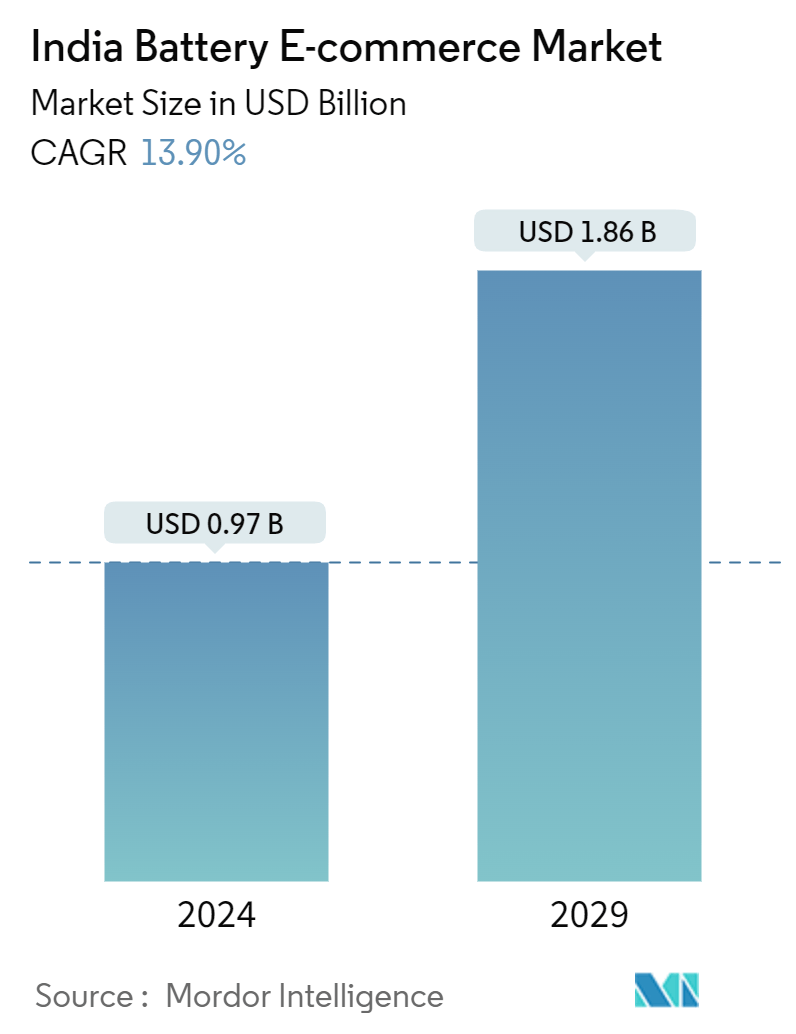
| Study Period | 2019 - 2029 |
| Base Year For Estimation | 2023 |
| Market Size (2024) | USD 0.97 Billion |
| Market Size (2029) | USD 1.86 Billion |
| CAGR (2024 - 2029) | 13.90 % |
| Market Concentration | Medium |
Major Players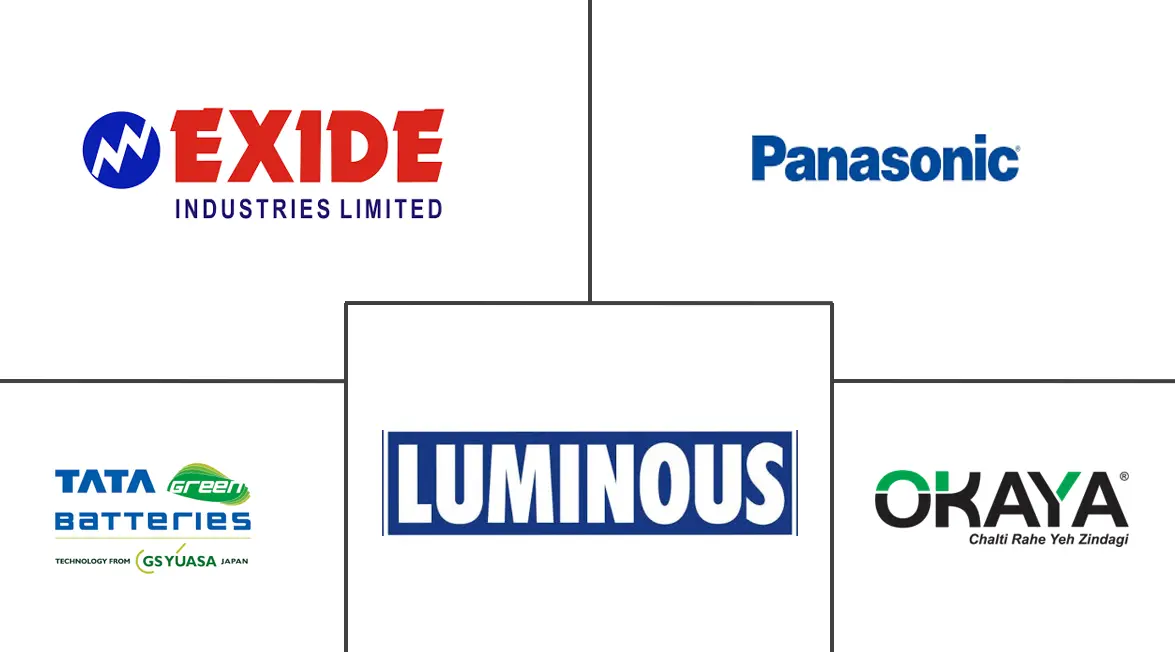
*Disclaimer: Major Players sorted in no particular order |
India Battery E-commerce Market Analysis
The India Battery E-commerce Market size is estimated at USD 0.97 billion in 2024, and is expected to reach USD 1.86 billion by 2029, growing at a CAGR of 13.90% during the forecast period (2024-2029).
- Over the medium period, the increasing adoption of electric vehicles and declining lithium-ion battery prices in India are expected to drive the market during the forecast period.
- On the other hand, the higher capital cost compared to traditional internal combustion engines and limited accessibility to the internet in rural parts of India are expected to hamper the market's growth.
- However, the increasing supportive government initiatives and technological advancements are expected to be a significant opportunity for the market during the forecast period.
India Battery E-commerce Market Trends
Increasing Adoption of Electric Vehicles
- As of 2023, India was among the world's top five emitters of CO2. To mitigate the air pollution problem, the government has taken the initiative to implement policies that are favorable to increasing the EV fleet count on the road.
- According to the Society of Manufacturers of Electric Vehicles (SMEV), the number of electric vehicles sold in 2023 was 1,179,958. In 2023, the country recorded the highest sales of battery electric vehicles, with 1.17 million units. A similar trend in India is expected to continue, considering the inclination of customers toward e-mobility.
- The Government of India emphasizes that entities planning to set up charging stations may not require licensing from the ministry. The Indian government set a target of EV sales accounting for 30% of private cars, 70% of commercial vehicles, and 80% of two and three-wheelers by 2030. These initiatives are expected to drive the country's demand for batteries. As of March 2023, there were 6,586 operational public EV charging stations (PCS).
- India is targeting the increase in the uptake of electric vehicles (EVs) through a subsidy program called the Faster Adoption and Manufacturing of Electric Vehicles (FAME) by 2030, which was introduced in 2015. The second phase of the policy, FAME‐II, was approved in 2019, with a budget of USD 1.4 billion for three years. Subsidies are available only for vehicles with advanced battery chemistries, such as lithium-ion, rather than lead‐acid, which makes up most of the electric two/three‐wheelers sold. The FAME‐II aims to increase the number of electric buses, two‐/three‐wheelers, and cars, which is expected to increase the demand for lithium-ion batteries.
- Multiple state governments, such as Gujarat, Telangana, Andhra Pradesh, and Karnataka, are offering capital subsidies for setting up lithium-ion giga-factories in the country by providing land, power, and water for the li-ion battery manufacturing units at a concessional rate. These efforts, combined with a growing awareness of environmental sustainability, encourage consumers to choose electric vehicles, boosting the demand for batteries through e-commerce channels.
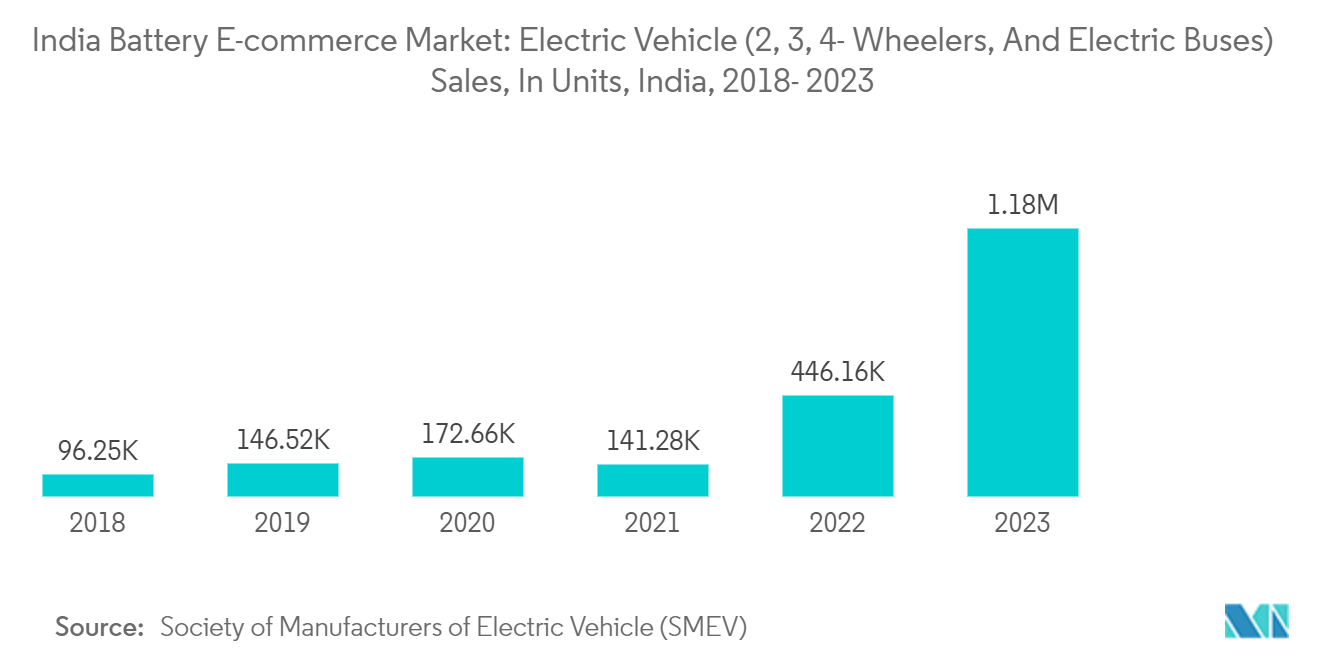
The Lithium- Ion Battery Segment to Dominate the Market
- Lithium-ion batteries are gaining more popularity than other battery types due to their favorable capacity-to-weight ratio. Other factors boosting its adoption include better performance, better shelf life, and a decreasing price.
- The price of lithium-ion batteries is usually higher than other batteries. However, major players across the market have been investing to gain economies of scale and R&D activities to enhance their performance, increasing the competition and, in turn, declining lithium-ion battery prices.
- Lithium-ion battery manufacturers are focusing on reducing the cost of Lithium-ion batteries. The price of lithium-ion batteries declined steeply over the past 10 years. In 2023, an average lithium-ion battery was valued at around USD 139 per kWh. It witnessed a decrease in the price of more than 85% in 2023 compared to 2010.
- As lithium-ion battery prices decline, electric vehicle (EV) ownership becomes more affordable for consumers in India. This increased affordability directly contributes to the growth of the EV market, subsequently driving the demand for batteries.
- The two principal reasons for the drastic cost decline are the steady improvement of battery performance achieved through sustained R&D aimed at improving battery materials, reducing the amount of non-active materials and the cost of materials, improving cell design and production yield, and increasing production speed.
- BloombergNEF anticipates that battery costs will decline again in 2024 as more extraction and refinery capacity become operational and lithium prices begin to ease. The average pack price will drop below USD 100/kWh in 2026.
- Hence, declining cost, along with its advantages over the other type of batteries like lead-acid, the segment is expected to dominate the market in the forecast period.
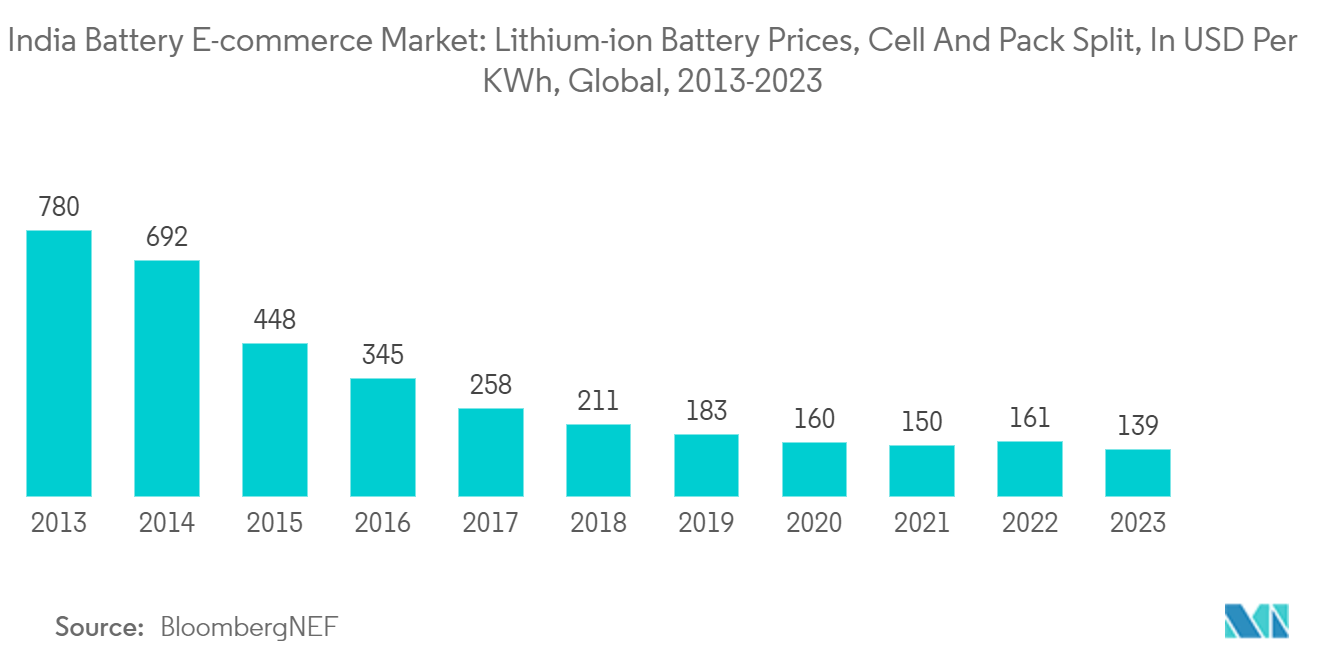
India Battery E-commerce Industry Overview
The Indian battery e-commerce market is semi-fragmented. Some of the key players in this market include Exide Industries Ltd, Luminous Power Technologies Pvt. Ltd, Panasonic Corporation, TATA AutoComp GY Batteries Pvt. Ltd, and Okaya Power Pvt. Ltd.
India Battery E-commerce Market Leaders
-
Exide Industries Ltd.
-
Luminous Power Technologies Pvt.
-
Panasonic Corporation
-
TATA AutoComp GY Batteries Pvt. Ltd
-
Okaya Power Pvt. Ltd.
*Disclaimer: Major Players sorted in no particular order
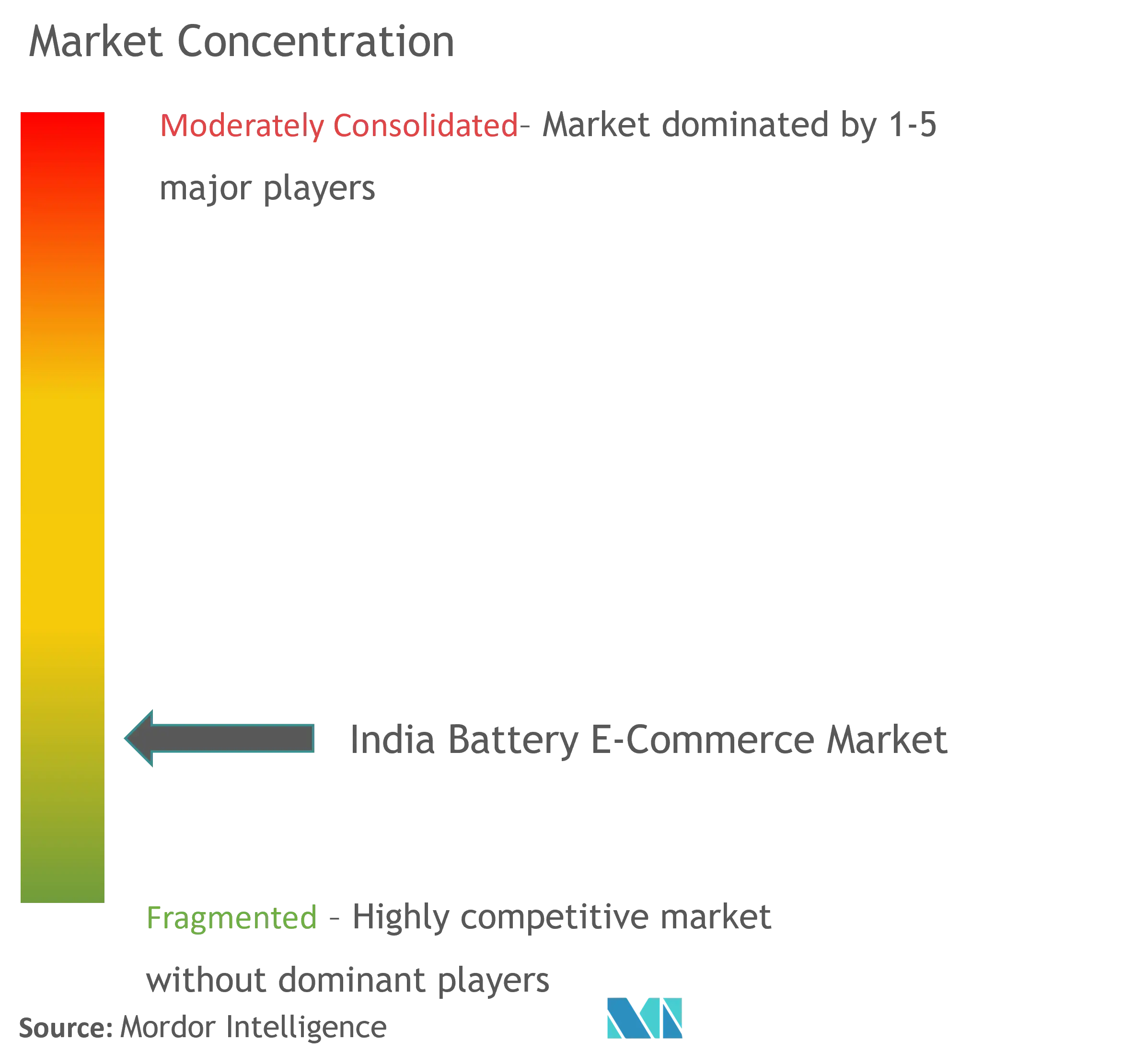
India Battery E-commerce Market News
- October 2023: Ola Electric announced the establishment of a lithium-ion cell manufacturing unit, touted to be the first in India, with a fundraising of about USD 385 million. Ola Electric has noted its plans to set up the unit at Krishnagiri, Tamil Nadu.
- June 2023: Tata Group signed an outline deal for building a lithium-ion cell factory with an investment of about USD 1.58 billion. The EV battery plant will help the nation create its electric vehicle supply chain rather than rely on imports. The plant will be located in Gujarat and likely have an initial manufacturing capacity of 20 Gigawatt hours (GWh).
India Battery E-commerce Market Report - Table of Contents
1. INTRODUCTION
- 1.1 Scope of Study
- 1.2 Market Definition
- 1.3 Study Assumptions
2. RESEARCH METHODOLOGY
3. EXECUTIVE SUMMARY
4. MARKET OVERVIEW
- 4.1 Introduction
- 4.2 Market Size and Demand Forecast in USD billion, till 2029
- 4.3 Recent Trends and Developments
- 4.4 Government Policies and Regulations
-
4.5 Market Dynamics
- 4.5.1 Drivers
- 4.5.1.1 Increasing Adoption of Electric Vehicles
- 4.5.1.2 Declining Lithium-Ion Battery Prices
- 4.5.2 Restraints
- 4.5.2.1 Limited Accessibility to Internet in Rural Parts
- 4.6 Supply Chain Analysis
- 4.7 PESTLE Analysis
- 4.8 Investment Analysis
5. MARKET SEGMENTATION
-
5.1 Battery Type
- 5.1.1 Lead-Acid
- 5.1.2 Lithium-Ion
- 5.1.3 Others
6. COMPETITIVE LANDSCAPE
- 6.1 Mergers & Acquisitions, Joint Ventures, Collaborations, and Agreements
- 6.2 Strategies Adopted by Leading Players
-
6.3 Company Profiles
- 6.3.1 Exide Industries Ltd.
- 6.3.2 Luminous Power Technologies Pvt. Ltd
- 6.3.3 Panasonic Corporation
- 6.3.4 TATA AutoComp GY Batteries Pvt. Ltd
- 6.3.5 Okaya Power Pvt. Ltd.
- 6.3.6 LG Chem Ltd.
- 6.3.7 Samsung SDI Co. Ltd
- 6.3.8 BYD Co. Ltd
- 6.3.9 East Penn Manufacturing Company
- 6.3.10 Hitachi Ltd
- *List Not Exhaustive
- 6.4 Market Ranking/Share(%) Analysis
- 6.5 List of Other Prominent Companies
7. MARKET OPPORTUNITIES AND FUTURE TRENDS
- 7.1 The Increasing Supportive Government Initiatives and Technological Advancements
India Battery E-commerce Industry Segmentation
Battery e-commerce refers to buying and selling batteries online through electronic platforms or websites. This involves transactions related to various types of batteries, including but not limited to those used in electronic devices, vehicles, renewable energy systems, and other applications.
The Indian battery e-commerce market is segmented by battery type. By battery type, the market is segmented into lead-acid, lithium-ion, and other battery type. The report also covers the market size and forecasts for the Indian battery e-commerce market across major states. Market sizing and forecasts are made for each segment based on revenue (USD).
| Battery Type | Lead-Acid |
| Lithium-Ion | |
| Others |
India Battery E-commerce Market Research FAQs
How big is the India Battery E-commerce Market?
The India Battery E-commerce Market size is expected to reach USD 0.97 billion in 2024 and grow at a CAGR of 13.90% to reach USD 1.86 billion by 2029.
What is the current India Battery E-commerce Market size?
In 2024, the India Battery E-commerce Market size is expected to reach USD 0.97 billion.
Who are the key players in India Battery E-commerce Market?
Exide Industries Ltd., Luminous Power Technologies Pvt., Panasonic Corporation, TATA AutoComp GY Batteries Pvt. Ltd and Okaya Power Pvt. Ltd. are the major companies operating in the India Battery E-commerce Market.
What years does this India Battery E-commerce Market cover, and what was the market size in 2023?
In 2023, the India Battery E-commerce Market size was estimated at USD 0.84 billion. The report covers the India Battery E-commerce Market historical market size for years: 2019, 2020, 2021, 2022 and 2023. The report also forecasts the India Battery E-commerce Market size for years: 2024, 2025, 2026, 2027, 2028 and 2029.
India Battery E-commerce Industry Report
Statistics for the 2024 India Battery E-commerce market share, size and revenue growth rate, created by Mordor Intelligence™ Industry Reports. India Battery E-commerce analysis includes a market forecast outlook for 2024 to 2029 and historical overview. Get a sample of this industry analysis as a free report PDF download.



